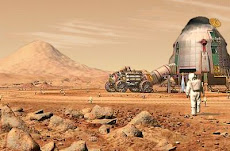
Mud volcanoes are unusual geological structures that blast up sediments from deep underground. Such volcanoes are doubly perfect places to look for life on Mars - they spew out secrets of ancient Mars while providing the perfect environment for life.
Mud volcanoes are structures in which gas, liquid and mud (or, more technically speaking, fine-grained rock) are shot up from miles underground in much the same way regular volcanoes force up magma. The sentiments revealed by these volcanoes come from buried layers that we wouldn't normally be able to see without drilling deep into the red planet's surface. According to NASA scientist Dorothy Oehler, that helps make the mud volcanoes of Mars's Acidalia Planitia the perfect place to look for life:
"If there was life on Mars, it probably developed in a fluid-rich environment. Mud volcanoes themselves are an indicator of a fluid-rich subsurface, and they bring up material from relatively deep parts of the subsurface that we might not have a chance to see otherwise."
Oehler and her research partner Carlton Allen have mapped 18,000 mud volcanoes in this region of Mars, and they estimate another 20,000 or so could be found if mapping continues. They used new images from the Mars Reconnaissance Orbiter along with data from a state-of-the-art imaging spectrometer to first find the volcanoes and then to figure out their mineralogical makeup. These studies showed conclusively that they were indeed mud volcanoes, ruling out the possibilities that they were caused by other processes like meteorite impacts, ice, or evaporation.
We've known about the volcanoes since the Viking probe discovered them in the 1970s, but only recently have astronomers suggested they could be mud volcanoes. One of the first to suggest this possibility was Kenneth Tanaka of the U.S. Geological Survey:
"I also thought that these features, which also occur elsewhere in the northern plains of Mars, were good places to search for signs of life. If life were present in the subsurface, the water and slurries involved in forming the mud volcanoes would have brought it to the surface. While life may not have survived at the surface, it at least could have been brought there by this process."
The Martian surface is probably too tough an environment for life to survive up there, but it's possible microbes still survive deep down below. The sediments ejected by these volcanoes would give today's probes and robotic rovers - and, by extension, the scientists back on Earth - an opportunity to test the Martian underground for signs of organic life. It's our best chance to study deeply buried layers until we can build a drill on Mars, something that is probably decades away.
Still, there's still room for skepticism. As Tanaka points out, we may be getting to the mud volcanoes too late to learn the secrets they might have held:
"There has been a great amount of time [for UV radiation and other surface processes] to destroy possible microfossils in surface rocks and soils. For this reason, it is unclear if these features are the best places to search for preserved life. Better places might include recent crater impacts and deposits from younger flood discharges."
And yet, Oehler remains optimistic. It all comes down to that perfect combination of the right location for life to emerge and the right mechanism to bring the evidence up to the surface:
"We do believe that Acidalia is a place where life could have been abundant because of long-lived water sources. It is one of the better places to look for evidence of life - if life ever developed on Mars."
[Icarus via Astrobio]
Send an email to Alasdair Wilkins, the author of this post, at alasdair@io9.com.



